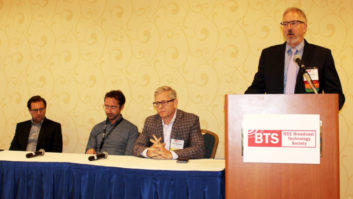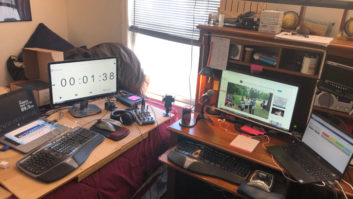It’s been several years since your masked rebel of radio reflection discussed the painfully slow HD Radio rollout and adoption as our digital platform for the future.
Lingering questions about the long-term viability of HD continue to dog our business. The larger markets have mostly all converted, but the total is only about 14 percent of all stations. Most uncommitted station owners are still reluctant to spend the money and the resources to add HD, uncertain that their investment will ever pay off.
Let’s break down the uncertainty and shed some clarity on how far HD has come and where it’s heading.
Stations started transmitting HD for evaluation and testing over a dozen years ago. The HD transmission standard was formally adopted by the FCC in October 2002. Since then, according to iBiquity, about 2,100 stations have added HD, including around 1,800 FMs, with 1,300 separate HD2 and HD3 channels.
By comparison, the latest FCC data indicates there are a total of 14,600 AM and FM stations in the country, not counting LPFMs.
The major stakeholders in this technology, including the early-adopting members of the HD Radio Alliance and the committed car companies, have hunkered down and stayed the course. A lot of us have not been happy with the proprietary standard aspect of the adopted iBiquity platform or the high licensing and royalty fees both broadcasters and radio manufacturers are being charged.
Unfortunately that’s the price we had to pay to play digital radio in an era when a private company develops a mission-critical product that corners the market. We need to realize the general model of adopting a technology innovation as a standardized platform is not all that different from most other industries.
GOOD NEWS AND NOT SO GOOD NEWS
FM-HD continues to grow, but it’s no secret AM-HD is struggling, with many of the 250+ converted stations choosing not to operate HD at night.
Limited data capacity with few feature enhancements of real value plus irresolvable interference issues have seemingly killed the promise of a technically rejuvenated digital AM service.
At least those stations that have added AM-HD got the added benefits of new transmitters and optimized antenna systems. The stations that have persevered and made AM-HD work as a valued addition to their product will be along for the ride as long as AM-HD decoding remains in the FCC adopted standard receiver chipsets.

Large-screen media display shows HD Radio will soon be available in the 2012 Ford Focus.
The additional channel bandwidth and adjacent channel guard bands for FM have allowed FM-HD to offer a much richer feature set than AM-HD and escape most of the dreaded interference problems. The early promises made for FM-HD suggested that our primary coverage contours would be served with the improved quality of digital using only 1 percent, or –20 dBc, of the total transmitted power. Car radios in unobstructed terrain almost delivered that promise, but we’ve since learned that effective digital coverage at –20 dBc in most markets achieves only about 60 to 70 percent of the analog.
Early versions of portable and tabletop HD radios came up especially short. It wasn’t that long ago when many pioneering engineers who installed HD systems on their stations had a difficult time finding HD Radio models that would reliably play their new signals inside a home or office without the aid of an external antenna. Many of the HD receiver makers have stepped up to attack this problem by improving their front-end designs, including better filtering and shielding to keep internally generated digital noise from de-sensing the radios.
SOLVING THE PUZZLE
Thanks to those ongoing receiver improvements and the excellent work of NPR Labs, which pushed the supplemental HD2/3 channels and increased HD power initiatives, a lot of the initial disappointment over HD performance has abated.
Increasing digital power from –20 dBc up to a maximum –10 dBc or 10 percent of total power has been demonstrated to improve digital coverage significantly. That factor by itself may be the missing piece that will make HD stick long-term.
About 300 U.S. stations are running increased HD power levels, mostly in the –14 dBc or 4 percent power range. That level appears to give digital coverage parity with analog. Even at –10 dBc, very few reported incidents of noticeable analog self-interference have emerged. The HD power boost is proving to be a welcome enhancement for the reliability of HD2 and HD3 channel reception.
Quite a few station clusters are now leveraging some commercial success with these additional program services. Many of those include extended coverage, especially at night, for their AM news, talk and sports stations. But it also provides minor league and extended major league sports franchise deals and various foreign-language services in major population centers. Even music-branded stations are developing unique niche formats that can super-serve targeted audiences that become very loyal and supportive when they discover them on an HD Radio.
LOTS OF FLAVORS AND COLORS
HD naysayers and opponents have warned from the beginning that if new HD receivers didn’t catch on quickly and sell in big quantities, the manufacturers would stop making them and abandon the technology. That has not happened.
A few of the early models have disappeared, but receiver and car radio companies continue to build and introduce new HD models in increasing quantities and at lower price points.
There are now more than 15 automakers building the technology into more than 85 different vehicle lines, and more than 100 HD Radio receiver models are available at more than 12,000 retail outlets nationwide.
According to iBiquity, 12 million HD Radio devices will be part of the national radioscape by the end of 2012, with many of these sporting larger color displays. It seemed like it took forever to cross the 1 million mark reached less than three years ago.
The multimedia color displays now appearing in many new car dashboards not only include navigation packages, but also a host of new glitzy features that offer Internet resources along with the enhanced visual features of HD Radio driven by PAD and other data. The HD Radio Artist Experience is one of those.
This summer, we’ll begin to see digital radios with large color touch screens showing up even in economy models of cars, with the Volkswagen Jetta being the first, and a number of others in early 2012. The new Ford Edge was previewed at the NAB Show in April with an awesome HD Radio system built in with Sync and a large color display, all standard. These next-gen HD radios will display album and commercial artwork as well as station logos.
The Artist Experience along with other HD visual features like real-time traffic maps and iTunes tagging allow radio to look and feel more like many of the new Internet destinations folks will be dialing up on their car dashboards. We simply need to provide the same level of eye-popping content variety and excellence to stay competitive in that space.
THE BATTLE FOR THE DASHBOARD
Most car radio companies don’t want to build old technology into new cars or additional radio chipsets just to support legacy products that will be going out of style. It’s no secret that radio is being squeezed by other interactive multimedia resources consumers want to see available on their car dashboards. The simple reality is that radio needs to keep justifying its right to claim a big chunk of this incredibly valuable ergonomic real estate in cars.
HD Radio as a consumer experience, for those who aren’t aware of it or haven’t been seeking it out, will be much like discovering RDS. They buy a new car and voilà, the RDS scrolling text and the HD radio with all its extra features are just there. Once they get turned on to the enhanced features of HD in the car, they’ll want to buy portable and table radios with those same features.
Public awareness of HD Radio admittedly has been disappointing and slow to pick up. But the increase has been accelerating in recent years.
The 2010 Edison Research study shows it in the 40–50 percent range, although many still confuse HD with satellite. Four years ago, it was only 10 percent.
In 2007, according to a Bridgeratings.com report, only 1 percent of consumers polled said they were interested in buying an HD radio. Edison shows 7 percent are now “very interested” in HD Radio, although this has remained about the same for the last three years. See edisonresearch.com/The_Infinite_Dial_2010.pdf.
Clearly, we still have a lot of work to do.
Sirius XM eventually will raise its monthly rates now that the three-year deal with the FCC to allow their merger is expiring; a recent settlement of a lawsuit by subscribers only delays an inevitable increase. Meanwhile, wireless Internet subscriptions for cars will no doubt start growing and hitting consumers’ pocketbooks. It should become even easier for free over-the-air radio, including HD, to exploit our zero cost advantage.
New and creative methods for stations to justify and afford converting to HD have been introduced. In case you missed it, Citadel Media offers radio stations iBiquity licensing and HD transmission equipment from major manufacturers in trade for spot inventory. It’s a partnership deal iBiquity and Citadel unveiled last fall as way for smaller and cash-strapped stations to add HD.
CHANGE IS IN THE AIR
So is HD Radio really worth the effort?
If I were a station owner committed to keeping my business viable and profitable going forward, I don’t think I’d want to rely on analog-only radio to sustain me. Nor would I succumb to the hype that ubiquitous wireless Internet is right around the corner and expect my Internet stream and website to take over and replace my air signal for the entire audience.
If you’re worried about the Internet completely replacing traditional over-the-air radio, it’s going to be quite a while before that’s likely to happen. And even when the technology and the necessary supporting infrastructure advance sufficiently across the country to make that possible, there will be an associated cost to acquire and maintain the service. Many consumers will not be willing to step up and pay the freight as long as free alternatives remain.
I’m comfortable letting future generations of station owners deal with that entire issue; technology continues to change and the market determines the time and the need to make the right decisions. For today and the immediate future, let’s stay focused on providing and selling compelling content on every delivery platform we can harness, and it won’t matter which one the listeners choose to receive it.
Guy Wire is a pseudonym for a veteran broadcast engineer.











